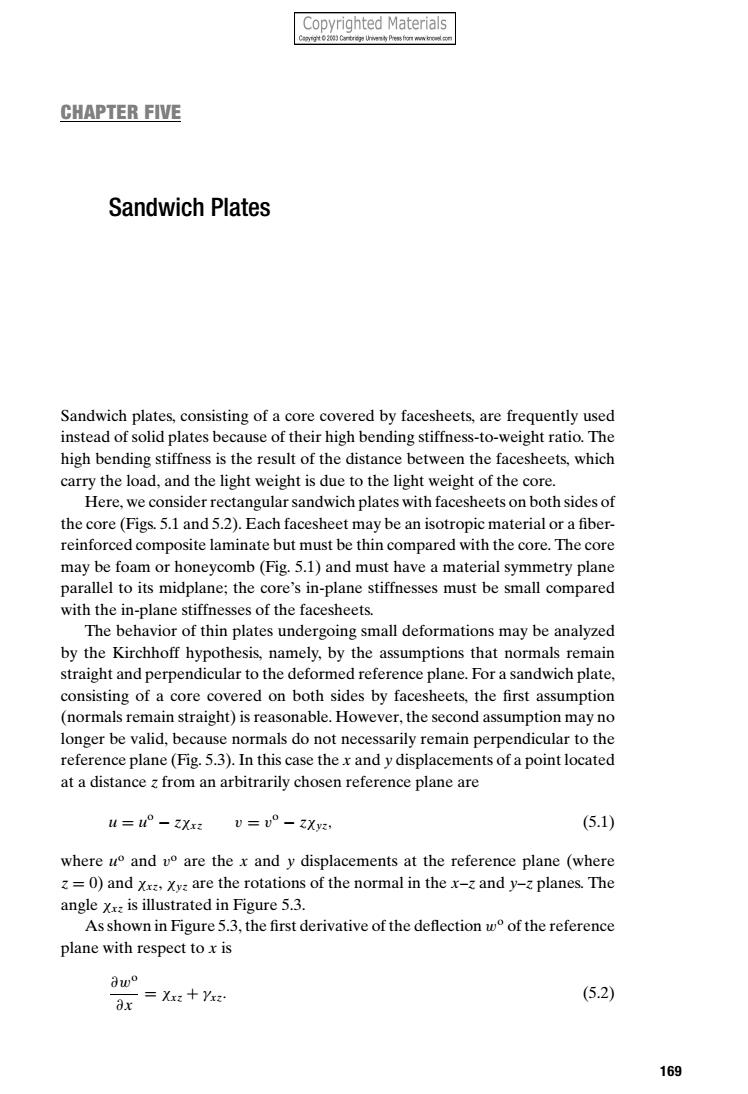正在加载图片...

Copyrighted Materials 0CpUyPress o CHAPTER FIVE Sandwich Plates Sandwich plates,consisting of a core covered by facesheets,are frequently used instead of solid plates because of their high bending stiffness-to-weight ratio.The high bending stiffness is the result of the distance between the facesheets,which carry the load,and the light weight is due to the light weight of the core. Here,we consider rectangular sandwich plates with facesheets on both sides of the core(Figs.5.1 and 5.2).Each facesheet may be an isotropic material or a fiber- reinforced composite laminate but must be thin compared with the core.The core may be foam or honeycomb(Fig.5.1)and must have a material symmetry plane parallel to its midplane;the core's in-plane stiffnesses must be small compared with the in-plane stiffnesses of the facesheets. The behavior of thin plates undergoing small deformations may be analyzed by the Kirchhoff hypothesis,namely,by the assumptions that normals remain straight and perpendicular to the deformed reference plane.For a sandwich plate, consisting of a core covered on both sides by facesheets,the first assumption (normals remain straight)is reasonable.However,the second assumption may no longer be valid,because normals do not necessarily remain perpendicular to the reference plane (Fig.5.3).In this case the x and y displacements of a point located at a distance z from an arbitrarily chosen reference plane are u=°-zXx:v=u°-ZXyz (5.1) where uo and vo are the x and y displacements at the reference plane (where =0)and xx,Xyz are the rotations of the normal in the x-z and y-z planes.The angle xr is illustrated in Figure 5.3. As shown in Figure 5.3,the first derivative of the deflection w of the reference plane with respect to x is 8w° =Xxz+yxz. (5.2) ax 169CHAPTER FIVE Sandwich Plates Sandwich plates, consisting of a core covered by facesheets, are frequently used instead of solid plates because of their high bending stiffness-to-weight ratio. The high bending stiffness is the result of the distance between the facesheets, which carry the load, and the light weight is due to the light weight of the core. Here, we consider rectangular sandwich plates with facesheets on both sides of the core (Figs. 5.1 and 5.2). Each facesheet may be an isotropic material or a fiberreinforced composite laminate but must be thin compared with the core. The core may be foam or honeycomb (Fig. 5.1) and must have a material symmetry plane parallel to its midplane; the core’s in-plane stiffnesses must be small compared with the in-plane stiffnesses of the facesheets. The behavior of thin plates undergoing small deformations may be analyzed by the Kirchhoff hypothesis, namely, by the assumptions that normals remain straight and perpendicular to the deformed reference plane. For a sandwich plate, consisting of a core covered on both sides by facesheets, the first assumption (normals remain straight) is reasonable. However, the second assumption may no longer be valid, because normals do not necessarily remain perpendicular to the reference plane (Fig. 5.3). In this case the x and y displacements of a point located at a distance z from an arbitrarily chosen reference plane are u = uo − zχxz v = vo − zχyz, (5.1) where uo and vo are the x and y displacements at the reference plane (where z = 0) and χxz, χyz are the rotations of the normal in the x–z and y–z planes. The angle χxz is illustrated in Figure 5.3. As shown in Figure 5.3, the first derivative of the deflection wo of the reference plane with respect to x is ∂wo ∂x = χxz + γxz. (5.2) 169